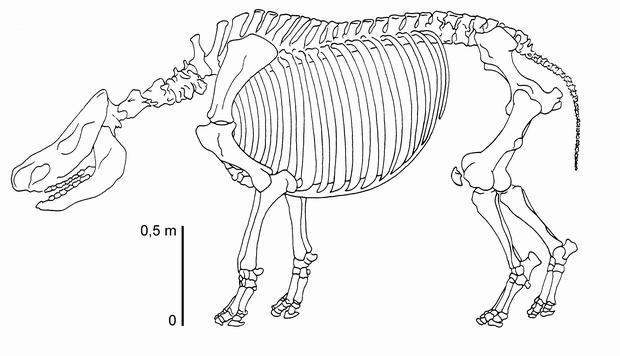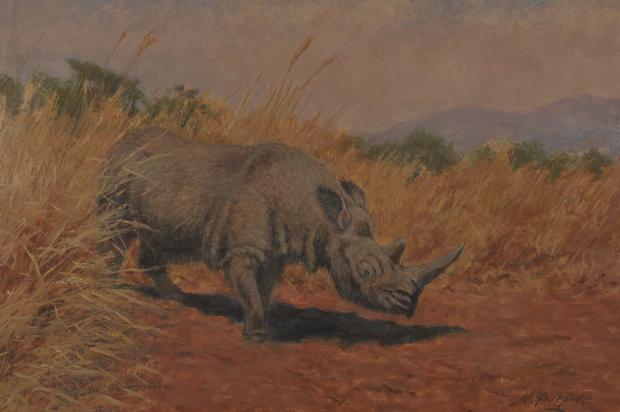But survival of the fitter(1) can be a fickle mistress. Why, after 800,000 years of successful survival did the Hundsheim rhino (Stephanorhinus hundsheimensis) suddenly and irrecoverably disappear?
These hearty guys survived the Ice Age. They were spread across wide areas and over the last 2.6 million years, evidence has been found showing Europe has been inhabited by six different types of highly varied species requiring differing ecological requirements. Some were at home on the cold steppes of the north and others preferred moderate and even warm climates. Occasionally, multiple species of rhinoceros even appeared at the same time.
Why one species was superior to another in terms of its evolution can now be shown through recent paleontological finds, say researchers writing in Quaternary Science Reviews.

Skull remains of a female Hundsheim rhino from Thuringia with a complete set of teeth, the horns do not survive (photo: T. Korn, Senckenberg Weimar)
Professor Ralf-Dietrich Kahlke from the Senckenberg Research Institute, Research Station of Quaternary Paleontology (Weimar) and paleo-ecologist Dr. Thomas M. Kaiser from the University of Hamburg analyzed 740 fossilized dental and bone fragments originating from 700,000 year-old clay in Voigtstedt and gravel deposits from Süssenborn in Thuringia, a few thousand years younger. Both dig sites revealed evidence of the Hundsheim rhinoceros, which takes its name from an Austrian fossil site.
Using mesowear analysis, a tooth-wear scoring method introduced in 2000 AD for determining the lifelong diet of an animal, they were able to reconstruct the dietary spectra of the two rhino groups; their preferred foods left traces on the teeth and the tooth 'relief' changed in a characteristic manner, enabling then to draw conclusions about what the animal commonly ate.
The Voigtstedt rhinoceros ate soft foliage from forests but the tooth reliefs from the Süssenborn animals showed evidence of a harsh steppes diet almost entirely comprising grass. Broad dietary spectra demonstrate a broad ecological tolerance on the part of the Hundsheim rhino; they were true survivors, dominated both steppes and forests for almost a million years - making their extinction an even more interesting science mystery.

Skeletal reconstruction of the Hundsheim rhino based on bone remains from Thuringia (image: R.-D. Kahlke, Senckenberg Weimar)
The hypothesis is that their end arrived not due to global warming or a lack of money-seeking environmental groups, but from plain old natural selection. 600-500,000 years ago, during extended cold and hot periods respectively, two more-specialized rhino types came into being that were better suited to the steppe and forest nutrition the Hundsheim rhino ate.
Stephanorhinus kirchbergensis, the Merck's rhinoceros, displaced the Hundsheim rhino in the forest habitats due to anatomical characteristics that made it better adapted to forest habitats while another competitor, Stephanorhinus hemitoechus, did the same on the open plains.
It had survived for thousands of generations but within a few thousand years Stephanorhinus hundsheimensis had become entirely extinct. The researchers say their paleontological finds verify that it didn't take asteroids or hunters to wipe them out, just better evolved species of rhinoceros.

The Hundsheim rhino reconstructed on the basis of bone remains (oil painting: C. C. Flerov, Sammlungen Senckenberg Weimar)
“The fact that species die out is something entirely natural,” says Kahlke, “although this does not give carte blanche with respect to the environmental sins of modern industry, which have caused and continue to cause the mass extinction of species such as we have never seen before.”
In other words, we're all likely to adapt as long as we don't try too hard at killing our environment.
Citation: Kahlke, R.-D., Kaiser, T. M. (2010): Generalism as a subsistence strategy: advantages and limitations of the highly flexible feeding traits of Pleistocene Stephanorhinus hundsheimensis (Rhinocerotidae, Mammalia). - Quaternary Science Reviews; Elsevier doi: 10.1016/j.quascirev.2009.12.012.
NOTES:
(1) Because survival of the fittest was always an unfortunate term which gets used a lot by sociopaths, like Hitler, Stalin, Mao and Keith Olbermann



Comments